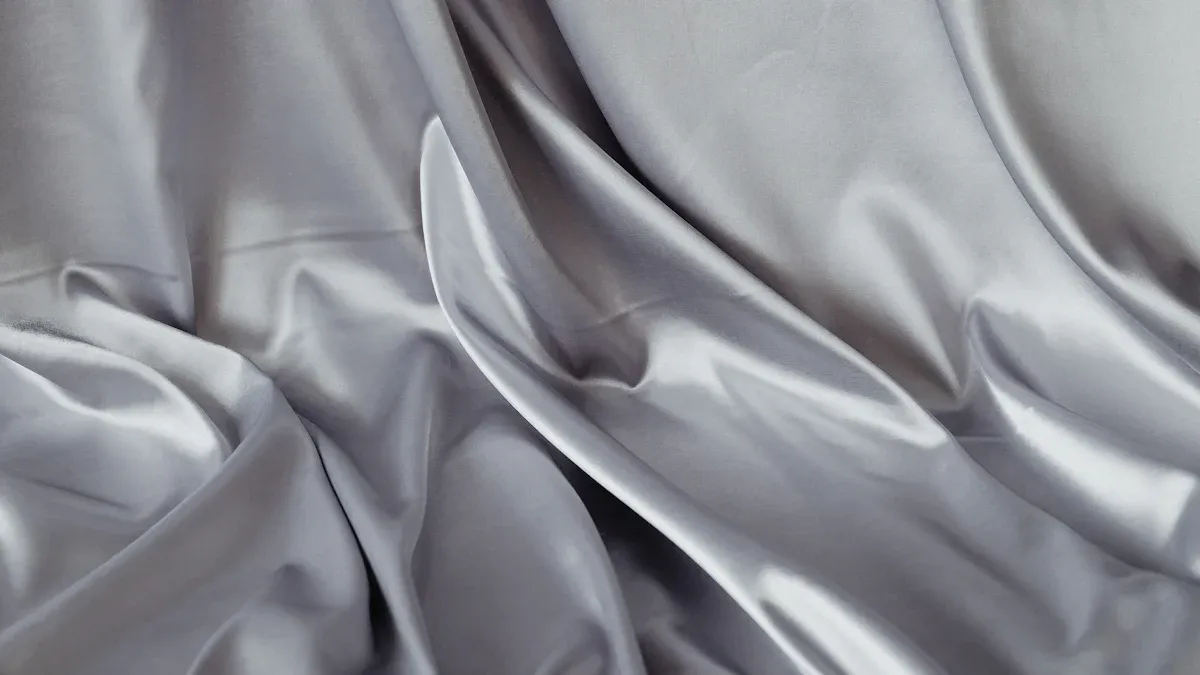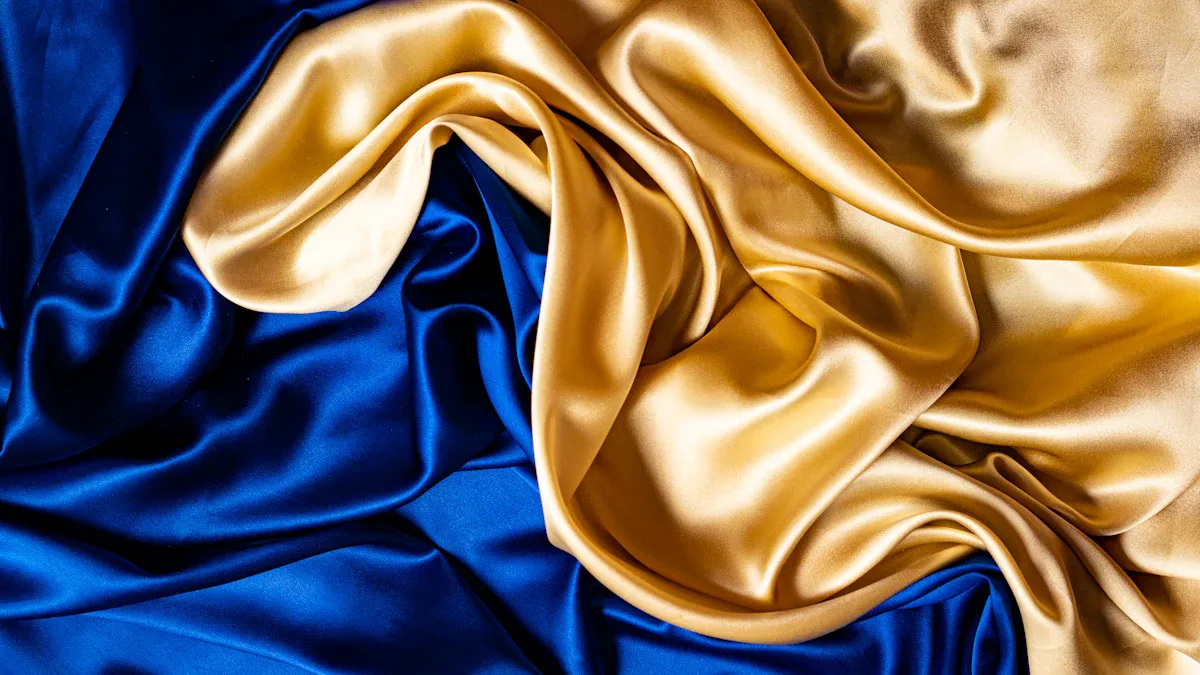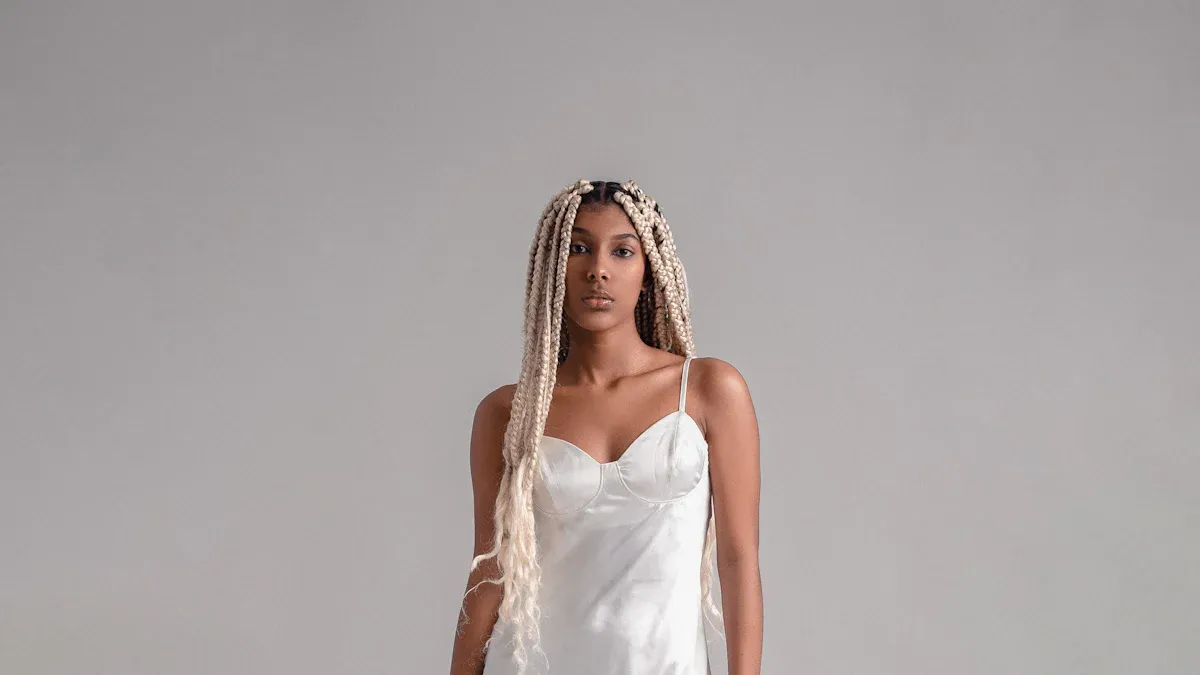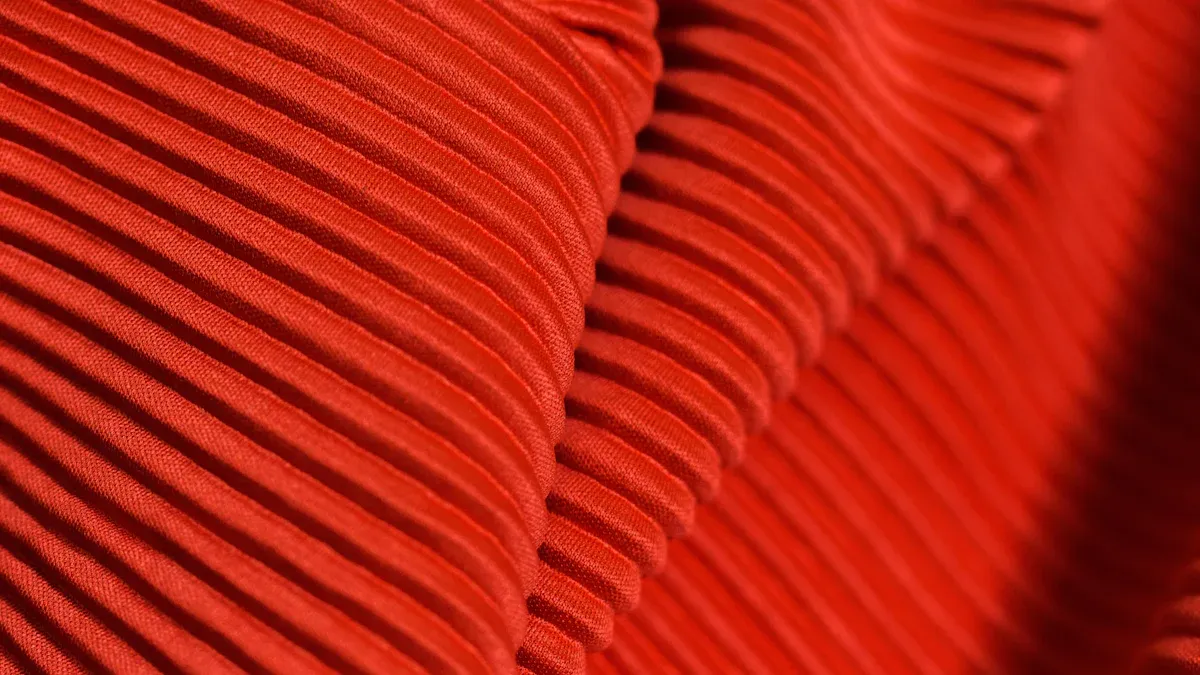
You experience the allure of satin when you choose silky satin fabric for your next design. Its luxurious appearance and soft texture elevate your projects, making your creations stand out. Satin fabric brings a unique sheen that transforms fashion, bridal, and home décor. Over the past decade, satin has gained popularity among millennials and Gen Z, and major retailers now offer more satin products. Recent innovations have made satin production more sustainable and improved quality.
| Market Growth | Consumer Demographics | Retail Trends |
|---|---|---|
| Home textile market projected to reach $200 billion by 2030 | Millennials and Gen Z drive demand for satin | Major retailers add satin to product lines |
Key Takeaways
- Silky satin fabric adds a luxurious look and feel to any design, making it ideal for fashion and home décor.
- High quality satin features a smooth surface that reduces friction, ensuring comfort against the skin.
- Satin’s unique sheen and elegant drape enhance visual appeal, making it perfect for special occasions like weddings and formal events.
- Choose the right type of satin for your project to achieve the desired look, whether it’s for clothing, accessories, or home textiles.
- Proper care and handling of satin fabric will maintain its beauty and durability, ensuring your creations last.
The Allure of Satin: What Sets Silky Satin Fabric Apart

Luxurious Look and Silky Feel
When you select silky satin fabric for your project, you instantly elevate the design with a luxurious look and feel. This fabric stands out because of its smooth surface and gentle touch. Textile industry studies show that satin weave provides less vibrational feeling compared to other weaves. You experience a soft sensation when you run your hand across high quality satin fabric. The Kawabata Evaluation System (KES-f) measures surface characteristics and confirms that satin’s smooth surface results in lower friction. This means you get a fabric that feels gentle and comfortable against the skin.
| Aspect | Findings |
|---|---|
| Surface Roughness Measurement | Satin weave provides less vibrational feeling than other weaves. |
| Fabric Hand Expressions | Smoothness and stiffness are key tactile qualities in satin. |
| Total Hand Value | Satin scores higher due to its smoothness. |
| Friction and Roughness Testing | Satin’s smooth surface results in lower friction. |
You notice the difference immediately. High quality satin fabric offers a tactile experience that sets it apart from other textiles. The luxurious fabric makes your garments or décor pieces feel special and refined.
Signature Sheen and Elegant Drape
Satin’s signature sheen gives your designs a radiant finish. The glossy surface reflects light, creating a visual effect that draws attention. You see this effect in evening gowns, bridal wear, and upscale home décor. The weaving technique used in high quality satin creates a glossy finish that enhances the fabric’s light-reflective quality. The lightweight design allows the fabric to drape beautifully, making it ideal for garments that require movement and flow.
| Characteristic | Description |
|---|---|
| Reflective properties | Enhances visual appeal and versatility. |
| Glossy finish | Sets satin apart from other fabrics, contributing to its sheen. |
| Lightweight design | Allows for a soft, flowing drape, ideal for elegant garments. |
| Weaving technique | Creates a glossy surface that enhances light-reflective quality. |
You achieve a luxurious look and feel with high quality satin fabric. The elegant drape ensures your creations move gracefully and maintain their shape.
The Play of Light and Movement
Satin’s weave structure enhances its ability to reflect light and create movement. You notice how the horizontal weft threads ride over multiple vertical warp threads. The long interweaving threads reflect more light, producing a shiny appearance. This structure allows the fabric to hang properly, enhancing movement in every design.
- The horizontal weft threads ride over multiple vertical warp threads.
- The long interweaving threads reflect more light, producing a shiny appearance.
- The structure allows the fabric to hang properly, enhancing movement.
For satin weaving, the horizontal weft threads ride from one to multiple vertical warp threads with at least four threads across and one under. This results in a smooth, glossy front that reflects light intensely.
When you use silky satin fabric, you create designs that shimmer and flow with every step. The high quality satin ensures your garments and décor pieces catch the light and move beautifully, making every project stand out.
Understanding Satin Fabric: Characteristics and Types
What Is Satin Fabric?
You encounter satin fabric in many luxury products today, but its story began centuries ago. Satin originated in ancient China, specifically in the port city of Quanzhou. The term ‘satin’ traveled through trade routes, shaped by Arabic and European languages. In the beginning, artisans wove satin fabric from pure silk, making it a symbol of wealth and status. Italian craftsmen introduced satin to the West in the 12th century. By the 14th century, satin became popular in Europe for royal garments and upholstery. Today, you find satin made from synthetic fibers like polyester and rayon, expanding its definition beyond silk.
- Satin fabric originated in ancient China.
- The term evolved through global trade.
- Early satin used silk and was reserved for the upper class.
- Western production started in Italy.
- Modern satin includes synthetic fibers.
Defining Features of High Quality Satin Fabric
When you choose high quality satin fabric, you notice several features that set it apart from lower quality alternatives. The table below highlights these differences:
| Characteristic | High-Quality Satin | Lower-Quality Satin |
|---|---|---|
| Fiber Type | Pure silk or high-quality fibers | Synthetic fibers |
| Surface Appearance | Glossy on one side, smooth | Too shiny or dull |
| Breathability | Very breathable | Poor breathability |
| Hypoallergenic | Yes | No |
| Static Electricity | Does not attract | Can attract static |
| Drapability | Dramatic, luxurious look | May cling, less elegant |
| Hair Compatibility | Reduces tangling | Can create friction |
You experience a smooth, glossy surface and dramatic drape with high quality satin fabric. This fabric feels gentle against your skin and reduces tangling, making it ideal for both fashion and home décor.
Types of Satin and the Suerte Collection
You discover many types of satin, each with unique qualities. Silk satin offers natural luxury, while polyester satin provides durability and easy care. Rayon satin delivers a soft touch and vibrant color. Recent innovations have introduced sustainable satin blends, combining natural and recycled fibers for eco-friendly options. You see the textile industry shifting toward these sustainable choices, maintaining high quality satin standards.
Suerte Textile offers a wide range of high quality satin fabric. You benefit from advanced production techniques, including digital printing, embroidery, and dyeing. The Suerte collection features customizable options, allowing you to select the perfect high quality satin for your project. You enjoy cost control, quick response times, and one-stop service, making your design process efficient and reliable.
Tip: When you select high quality satin fabric from the Suerte collection, you gain access to vibrant colors, lasting sheen, and extensive customization for any creative project.
Benefits of Choosing Satin for Your Design Projects
Timeless Elegance and Sophistication
You elevate your designs when you choose high quality satin fabric. This material brings a sense of luxury and refinement to every project. Designers rely on satin for its smooth finish and radiant shine, which instantly enhances the overall aesthetic. The fabric’s ability to catch light creates a premium look that stands out in both fashion and décor.
- Satin is a staple in evening wear and formal attire, making it ideal for special occasions.
- You see high quality satin used in wedding dresses, cocktail gowns, and high-end lingerie, emphasizing its timeless elegance.
- Satin fabric adds a touch of luxury to home décor items such as curtains, pillowcases, and tablecloths.
- The versatility of high quality satin allows you to create stylish outcomes across different styles and applications.
Professional designers appreciate how silky satin fabric transforms ordinary pieces into luxurious statements. You achieve a sophisticated look that never goes out of style.
Comfort and Softness Against the Skin
You experience exceptional comfort when you select high quality satin fabric for your garments or décor. The soft texture feels gentle against your skin, making it a preferred choice for clothing and bedding. Consumer studies show that cotton fabrics woven in satin weave rank highest in comfort properties. You notice the difference when you compare high quality satin to other materials.
- The soft surface of high quality satin reduces friction, providing a soothing sensation.
- You enjoy wearing garments made from silky satin fabric because they feel smooth and comfortable all day.
- Satin’s gentle touch makes it ideal for pillowcases and bedding, helping you relax and rest.
You create projects that prioritize comfort without sacrificing luxury. The soft feel of high quality satin ensures your designs are both beautiful and pleasant to wear or use.
Durability and Easy Maintenance
You benefit from the durability of high quality satin fabric in your design projects. Manufacturers test satin using abrasion, tear strength, and tensile strength methods to ensure it withstands daily use. These tests simulate natural wear, confirming that high quality satin maintains its appearance and structure over time.
| Testing Method | Description |
|---|---|
| Abrasion Testing | Measures how well a fabric withstands surface wear from rubbing, essential for high-traffic areas. |
| Tear Strength Test | Assesses the force required to tear the fabric, indicating its ability to withstand stress. |
| Tensile Strength Test | Measures resistance to being pulled apart, crucial for heavy-duty applications like furniture. |
You find high quality satin suitable for a range of uses, from delicate decorative pieces to heavy-duty upholstery. The fabric’s easy maintenance means you spend less time caring for your creations. You can rely on high quality satin to retain its vibrant colors and lasting sheen, even after repeated use.
- Delicate applications work well with less than 3,000 double rubs.
- Light duty pieces handle 3,000-9,000 double rubs.
- Medium duty items withstand 9,000-15,000 double rubs.
- Contract upholstery requires a minimum of 15,000 double rubs.
- Heavy-duty projects benefit from 15,000-30,000 rubs.
- Extra heavy-duty uses need 30,000 rubs or more.
You choose high quality satin fabric for its combination of luxury, durability, and easy care. Your designs remain vibrant and elegant, making every project a lasting success.
Vibrant Colors and Lasting Sheen
You want your designs to stand out with rich, eye-catching colors. Satin gives you this advantage. The fabric’s unique weave and smooth surface allow dyes to penetrate deeply, resulting in vibrant hues that remain true over time. You notice how the colors pop, whether you choose bold jewel tones or soft pastels. Satin’s ability to reflect light enhances every shade, adding a touch of glamour to your creations.
You also benefit from satin’s lasting sheen. The glossy finish does not fade easily. You see the fabric maintain its shine even after repeated washing. Unlike other luxury fabrics, satin resists dullness and keeps its elegant appearance. The strength and elasticity of satin help it hold its shape and luster, so your garments and décor pieces look fresh and new longer.
Tip: Choose satin for projects that demand both color intensity and a radiant finish. You achieve a professional look that endures.
Here is a quick comparison of how satin performs against other luxury fabrics:
| Feature | Satin | Other Luxury Fabrics |
|---|---|---|
| Color Retention | Excellent | Good to Moderate |
| Sheen After Washing | Lasting | May Diminish |
| Shape Maintenance | Strong | Varies |
You create designs that capture attention and hold their beauty. Satin’s vibrant colors and lasting sheen ensure your work remains impressive, project after project.
Versatility of Satin Fabric in Fashion and Décor

Satin in Fashion Design
You see high quality satin featured in many fashion projects. Designers use satin in fashion to create luxury looks for evening gowns, red carpet dresses, and prom dress styles. Satin’s soft texture and signature sheen make it a top choice for both classic and modern designs. You notice satin in blouses, skirts, and even outerwear like jackets and coats. Satin pairs well with denim for a chic look and works with lace or chiffon for layered outfits. You find satin accessories such as headbands, bags, and ties add subtle glamour to any style.
| Use Category | Description |
|---|---|
| Evening Wear | Satin is favored for gowns and formal dresses, adding sophistication. |
| Casual Outfits | Used in blouses and skirts, satin pairs well with denim for a chic look. |
| Outerwear | Satin jackets and coats are trendy options that elevate outfits. |
| Accessories | Commonly found in headbands, bags, and ties for subtle glamour. |
| Classic Styles | Associated with vintage and retro-inspired fashion trends. |
| Seasonal Adaptability | Suitable for all seasons, with lighter blends for summer and heavier for winter. |
| Color Variety | Can be dyed in various colors, adaptable to trends and personal styles. |
| Textural Play | Pairs well with fabrics like lace and chiffon for layered looks. |
Tip: You can choose high quality satin for projects that need vibrant colors and a luxury finish.
Bridal and Special Occasion Uses
You select high quality satin for bridal gowns and special occasion dresses because it brings luxury and elegance. Brides prefer satin for its soft feel and radiant shine. The satin segment in the bridal gowns market is growing and remains dominant. You see satin used in bridal gown designs, red carpet dresses, and prom dress styles. Satin’s smooth surface and lasting sheen make it ideal for formal events. You notice that bridal and special occasion uses often require fabrics that drape beautifully and hold their shape. Satin meets these needs, making it a favorite among designers and brides.
Note: Many people think satin is always made of silk, but experts explain that satin refers to the weave, not the fiber. You find satin made from polyester, rayon, and cotton, offering more choices for your projects.
Satin Fabric for Home Décor and Accessories
You bring luxury into your home with high quality satin fabric. Satin’s soft touch and elegant shine make it perfect for curtains, bedding, and decorative accents. Crepe back satin is popular for curtains and drapery because it works for both light and heavy window treatments. You enjoy bedding and cushions with reversible crepe back satin, which gives you a soft satin side and a textured crepe side. Satin table linens and slipcovers add a modern touch to your décor. You see new trends focusing on sustainability, versatility, and fresh colors and patterns in satin home décor.
| Application | Description |
|---|---|
| Curtains and Drapery | Crepe back satin is favored for its elegant shine and versatility in design, suitable for both light and heavy window treatments. |
| Bedding and Cushions | The reversible nature of crepe back satin provides both a luxurious satin side and a textured crepe side, enhancing comfort and aesthetics. |
| Decorative Accents | Used for table linens and slipcovers, crepe back satin adds a touch of luxury and modernity to home décor. |
| Emerging Trends | Focus on sustainability, versatility in design, and new colors and patterns are shaping the use of satin in home décor. |
You can choose natural satin for superior breathability and comfort, or synthetic satin for easy care and durability. Both types offer luxury and style for your home projects.
Practical Tips for Working with Satin Fabric
Cutting and Sewing Techniques for Satin
You face unique challenges when working with satin. The fabric’s smooth surface can slip while you cut or sew. You achieve better results by using sharp scissors and a rotary cutter for clean edges. Place tissue paper under the fabric to prevent shifting. When sewing satin, select a fine, sharp needle to avoid snags. Adjust your machine’s tension settings for even stitches. Use high-quality thread and consider a stabilizer to reduce puckering. Test your design on a scrap piece before starting your main project.
| Challenge | Solution |
|---|---|
| Puckering | Use stabilizers, adjust tension, and hooping techniques. |
| Thread Breakage | Choose quality threads, set proper tension, and use thread conditioners. |
| Design Distortion | Simplify designs, enlarge small elements, and test on similar fabric. |
| Needle Selection | Use a sharp, fine needle for delicate fabrics. |
Tip: Always handle satin gently to maintain its elegant appearance.
Caring for Satin Garments and Décor
You keep your satin garments and décor looking new by following simple care steps. Always read the label for specific instructions. Handle the fabric with care to prevent snags and stretching. Avoid direct heat; use low settings when ironing or steaming. Remove wrinkles by steaming or ironing inside out with a cloth barrier. Dry items away from sunlight to protect colors. Store pieces on padded hangers or with tissue paper to prevent creases. Blot spills gently and avoid sharp jewelry that may catch on the fabric.
- Read the label carefully
- Handle with care
- Avoid direct heat
- Remove wrinkles carefully
- Avoid sunlight
- Store properly
- Clean spills immediately
- Be careful with jewelry
Selecting the Right Satin for Your Project
You select the best satin by considering its characteristics and intended use. Examine samples from reputable sellers to ensure quality. Look for the right level of sheen and luster for your design. Buying in bulk helps you save on larger projects.
| Type of Satin | Characteristics | Suitable Applications |
|---|---|---|
| Antique Satin | Heavy, textured, dull | Curtains, upholstery, bedding |
| Baronet Satin | Lustrous, silk-like shine, cotton back | Bedsheets, footwear, accessories |
| Stretch Satin | Elasticity from spandex or Lycra | Lingerie, bridal wear, fitted dresses |
| Crepe Black Satin | Double-sided, excellent drape | Special occasion dresses |
| Duchess | Glossy finish, elegant | Bridal couture, evening gowns |
| Charmeuse | Lustrous sheen, lightweight | Dresses, bridesmaid dresses |
| Double Faced Satin | Reversible, shiny both sides | Ribbons, decorations |
| Slipper Satin | Firm, lustrous, polyester | Table cloths, décor items |
Note: You make confident choices by matching the satin type to your project’s needs.
You unlock endless creative possibilities when you choose silky satin fabric for your next project. The unmatched sheen, softness, and durability set your designs apart. Explore the Suerte collection to find high quality satin that meets your needs. Satin fabric brings beauty, comfort, and versatility to fashion, bridal, and home décor.
Discover how satin elevates every design. Select the right fabric and create something extraordinary.
FAQ
What makes satin fabric ideal for luxury projects?
You choose satin fabric for luxury projects because it offers a beautiful drape and a luxurious touch. The fabric’s smooth surface and radiant sheen add elegance to garments, décor, and accessories. Satin fabric drapes smoothly, making it perfect for designs that need an extra touch of glamour.
How do you care for satin fabric to maintain its elegance?
You keep satin fabric looking new by washing it gently and avoiding harsh chemicals. Use cool water and mild detergent. Air dry your projects to preserve the beautiful drape and luxurious touch. Store satin items away from sunlight to protect their vibrant colors and sheen.
What are some ideal projects for satin fabric?
You create ideal projects for satin fabric such as evening gowns, bridal dresses, curtains, pillowcases, and table linens. Satin fabric drapes smoothly, so it works well for DIY satin projects that require a beautiful drape and an extra touch of glamour.
Can beginners use satin fabric for DIY satin projects?
You can use satin fabric for DIY satin projects even if you are a beginner. Choose simple patterns and practice cutting with sharp tools. Satin fabric drapes smoothly, so you achieve a professional look with basic sewing skills. You add elegance to your creations with this fabric.
Why does satin fabric drape smoothly in different projects?
You notice satin fabric drapes smoothly because of its unique weave and soft texture. The fabric’s structure allows it to flow and hang with a beautiful drape. This quality gives your projects an extra touch of glamour and elegance.



